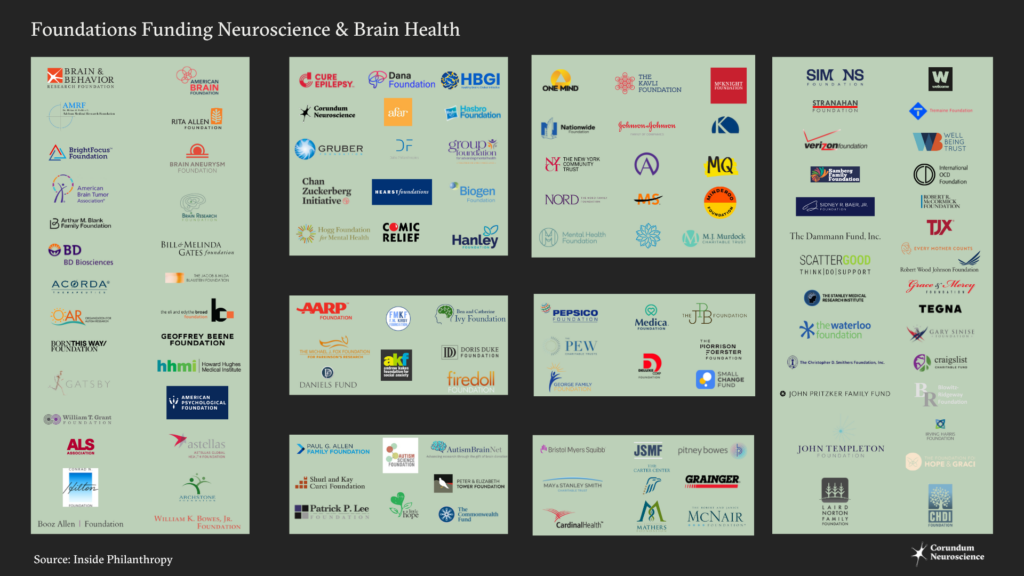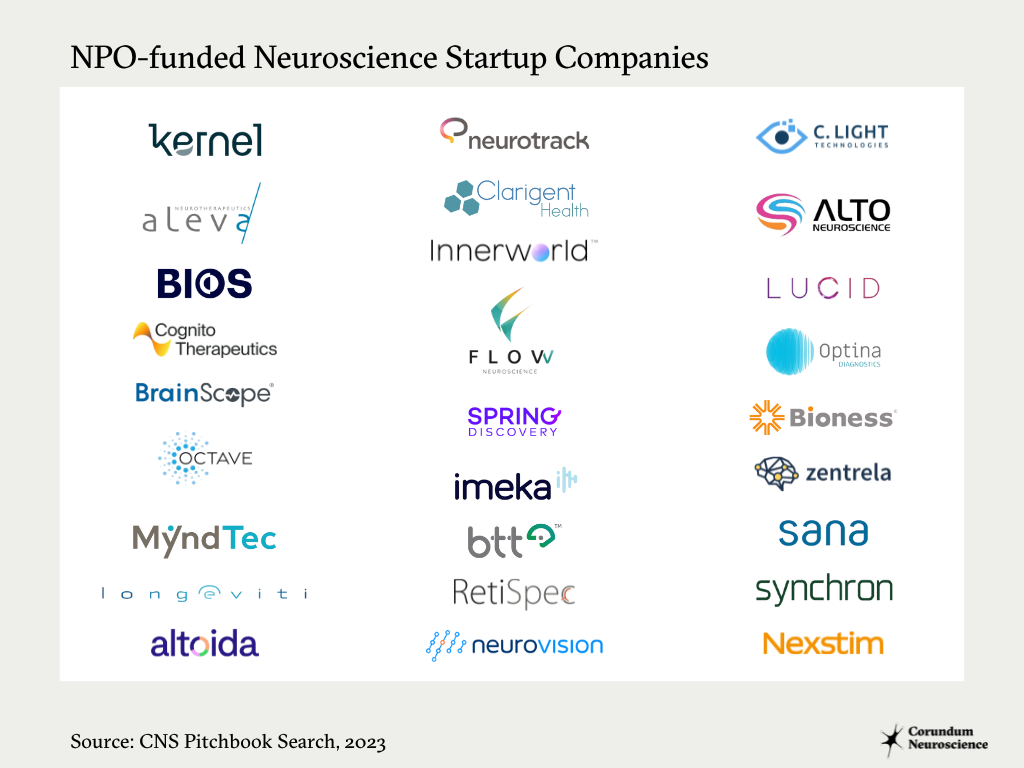At Corundum Neuroscience, we believe philanthropy can be an instrumental funding vehicle for many neuroscience researchers and entrepreneurs pursuing uncharted areas of science innovation. This brief highlights the imperative role of philanthropy in science, maps out the nonprofit neuroscience funding landscape, and explores emerging funding trends and priorities. In doing so, we aim to illustrate to entrepreneurs and researchers the active role that philanthropy serves in advancing neuroscience research and innovation.
Philanthropy for Science
For over a century, philanthropic funding has played a prominent role in shaping the trajectory of scientific discovery. Alongside government funding, major individual donors and non-profit organizations (NPOs) have served as vital complementary partners, fueling research across diverse fields. A 2022 study reveals the impressive scale of this involvement: US NPOs dedicated a consistent $30 billion annually to science between 2010-2019. This stands in contrast to the National Institutes of Health (NIH) FY2024 budget of $46 billion, of which $3.8 billion is allocated to Alzheimer’s and dementia research.
As federal funding struggles to keep pace with inflation and looming concerns about low grant success rates at federal science agencies, philanthropy is likely to play an increasing role in bridging the gap and ensuring continued progress in scientific research.
A Flexible Partner for Scientific Innovation
Unlike their federal agency counterparts – often constrained by bureaucracy and short-term priorities – philanthropists thrive on flexibility, risk tolerance, and long-term vision. These unique set of traits allows philanthropists to play an outsized role in propelling scientific advancements in various key ways.
First, unburdened by the need for immediate results, philanthropists can provide crucial long-term funding, enabling scientists to pursue ambitious, potentially groundbreaking research that might not fit traditional grant timelines. Philanthropists also often direct funds towards basic science, an area that may face limited government support, and in some cases help institutions acquire expensive equipment that falls outside the scope of government grants. Finally, philanthropists can act as early investors, de-risking promising projects by validating their potential and paving the way for larger government grants later.
Take for instance, the Vera C. Rubin Observatory in Chile; philanthropists assumed the risk of funding the development of a new mirror technology before the National Science Foundation (NSF) provided support. Such funding gaps illustrate the ways that philanthropists work to nurture and sustain an infrastructure that is both resilient and flexible for advancing science.

Philanthropy Ecosystem Supporting Neuroscience and Brain Health
The philanthropic landscape is notably heterogeneous and distributed, where a few large individual donors coexist with many small private funders. Funders with a primary focus on science together account for 93% of all scientific philanthropy. In the neurosciences, the philanthropic landscape is comprised of individual donors, NPOs – which includes private foundations, family foundations, community foundations, public charities, and corporate funders. Funding for neuroscience research relies disproportionately on individual donors, whose contributions often take the form of endowed or expendable gifts to universities or research institutes. While quantifying individual contributions can be challenging, a 2020-2021 analysis by the Chronicle of Philanthropy’s Big Gift Database identified $600 million for the construction of research facilities within neuroscience and neurology.
NPO and corporate funders are playing a smaller yet meaningful role in advancing neuroscience research by filling the gaps left by federal funding. A key example is the directed-use grant model, where philanthropists contribute to specific projects aligned with their interest. This approach accounted for a significant $4 billion (or 8%) of basic-science funding at universities and research institutes in 2016 alone.
In 2022, Stanford University announced a $75 million gift from the co-founder of Nike to establish the Phil and Penny Knight Initiative for Brain Resilience. Driven by the initiative to combat neurodegeneration, they will establish the Brain Resilience Laboratory as well as funding for innovation grants and postdoctoral scholars. Considering the varying interests and goals of NPOs supporting neuroscience, Inside Philanthropy’s 2023 report on Neuroscience Research identified the following subsets of funder types:

Funding Trends
Neuroscience research faces growing challenges. Declining grant acceptance rates are siphoning crucial resources, while top scientists are dedicating a staggering two-fifths of their time on activities outside of research such as looking for funding.
In response, philanthropists are emerging as champions of innovation, not simply by refining established funding methods, but by forging creative pathways to bolster resources, expand their reach, and ultimately, accelerate scientific progress. This shift has helped to facilitate a more supportive environment for neuroscience researchers and entrepreneurs, as evidenced by the following trends:
Rise of Nonprofit Venture Philanthropy
Philanthropists are venturing beyond traditional grant-funding by diversifying their impact strategies. A growing number are creating mission-related investment funds that blend elements of venture capital (VC) and nonprofit structures. These funds, sometimes referred to as “venture philanthropy,” operate as nonprofits managed by philanthropic sponsors but raise capital through donations. This unique approach empowers donors to directly influence investment decisions and ensure that any returns generated are reinvested for further impact, unlike traditional VC where profits go back to investors.
Venture Philanthropy offers several advantages:
Direct Impact: Donors have a greater say in how their contributions are used and can target them towards specific research areas or companies.
Higher Risk Tolerance: Unlike traditional grants, these funds can invest in riskier but potentially groundbreaking research that might struggle to secure funding elsewhere.
Sustainability: Reinvesting returns creates a perpetual funding source, amplifying the initial investment’s impact over time.
The potential of this model is exemplified by the Alzheimer’s Drug Discovery Foundation (ADDF), which has funded over 50 neuroscience companies in the past decade, both by awarding grants and participating in late stage funding rounds. “As a venture philanthropy, the ADDF seeks out and invests in the most promising, high-risk/high-reward science from biotech companies and academia that would go underfunded without us,” explains Chief Philanthropy Officer Jane McIntosh.
Underscoring this growing trend, the table below showcases non-drug neuroscience companies that have received funding from nonprofit VCs in recent years.

Linking Avenues for Collaboration
Recognizing the inherent complexity of neuroscience research, funders are increasingly embracing powerful partnerships like the US Brain Initiative to achieve meaningful advancements.
Collaborative funding seeks to break down silos and foster joint efforts across diverse stakeholders, including foundations, government agencies, academic institutions, industry leaders, venture capitalists, and philanthropic organizations.
Below are a few notable examples of collaborative funding in the neuroscience domain:
Breaking Silos | One major hurdle in research progress is the fragmented nature of funding across different entities. To tackle this challenge, the Research Corporation for Science Advancement (RCSA) took the initiative to coordinate collaborative funding opportunities for both new and established science philanthropists, fostering collaboration among organizations like the Heising-Simons Foundation, the Paul G. Allen Frontiers Group, the Chan Zuckerberg Initiative, and the Sloan Foundation.
Accelerating Diagnostics | In the area of Alzheimer’s and dementia research, the Alzheimer’s Drug Discovery Foundation (ADDF), co-founded by prominent figures like Leonard A. Lauder, Bill Gates, Jeff Bezos, and the Dolby Family, launched the Diagnostics Accelerator with the aim to find and fund bold ideas for easier, more accurate, and earlier diagnosis of these diseases. This initiative, with a total commitment of $100 million since 2018, has garnered additional support from diverse partners like the NFL Players Association, Eli Lilly & Company, Biogen, and the Shanahan Family Foundation, highlighting the power of collective action.
Brain Health Research | Launched in May 2021 at the World Economic Forum, The Health Brains Global Initiative (HBGI) is a $10 billion initiative to advance brain science breakthroughs. HBGI received initial funding and support from OneMind, the National Academy of Medicine, Johnson & Johnson, Otsuka and the Wellcome Trust.
Philanthropy Spinoffs – Focused Research Organizations
Traditional grant-funding for scientific research is seeing a transformation with the emergence of focused research organizations (FROs). FROs offer a unique alternative, allowing NPOs to directly invest and guide the direction of niche projects that might otherwise struggle to secure funding or languish on an idea shelf.
Unlike traditional avenues like academic labs, which might perceive some projects as too risky or complex, or industry/VC, where profitability takes precedence, FROs provide a vital lifeline. They can support projects like the one undertaken by E11 Bio, which aims to map the complex neural circuitry of the brain, a feat requiring experts who wouldn’t necessarily find suitable opportunities in traditional settings.
The potential of this model is evident in the joint $70 million commitment by the Astera Institute and the Buck Institute for Research on Aging to support an FRO studying longevity. Such collaborations unlock doors for groundbreaking research that holds immense promise for various fields.
Diversity, Equity, and Inclusion
As our population ages, concerns are intensifying around how neurological conditions disproportionately impact specific ethnic and racial groups. In response, funders are increasingly making diversity, equity, and inclusion (DEI) an important tenet of their grantmaking strategies. This shift aims to address representation gaps in clinical trials, understand the socioeconomic factors influencing health disparities, and embed equity within research organizations.
Key Focus Areas Include:
- Boosting Diversity in Clinical Trials: Initiatives like The Parkinson’s Foundation’s $10 million investment in 2021 actively recruit underrepresented minorities for crucial research.
- Examining Social Determinants of Health: Funders like The Sloan Foundation require grant proposals to address how research projects will promote broader participation, acknowledging the impact of social and economic factors on health outcomes.
- Promoting Equity Within Organizations: The overall goal is to foster more equitable and inclusive research environments across the board.
Such steps mark a crucial shift in acknowledging the disparities faced by specific groups and driving a more inclusive approach to neurological research.
Interdisciplinary Research
Funders are recognizing the immense potential of interdisciplinary research, viewing it as a fertile ground for uncovering unexpected discoveries and breakthroughs. In neuroscience, research into the underlying complexity of the brain often yields findings that can be applied to disorders associated with mental health.
“There’s a lot of interconnectedness and comorbidities, and when you fund this kind of research, you sometimes get findings that you didn’t expect,
Beth Lewin Dean, CEO, CURE Epilepsy
Organizations like The Kavli Foundation support research institutes exploring intersections between seemingly unrelated fields like astrophysics, theoretical physics, neuroscience, and nanoscience. By employing advanced computational, imaging, and visualization techniques across disciplines, interdisciplinary research collaborations aim to uncover previously unimaginable discoveries.
Crowdfunding
Crowdfunding, often referred to as “citizen science” in research contexts, has emerged as a novel funding method for researchers and entrepreneurs. While individual contributions might be smaller compared to traditional grants, these platforms have democratized access to funding, opening doors for innovative projects regardless of background or affiliation.
Several prominent philanthropic organizations, including the Simons Foundation, Schmidt Futures, and the Burroughs Wellcome Fund, have recognized and supported this trend. For instance, the Sloan Foundation directly funded the development of influential citizen science platforms like Zooniverse and SciStarter. Notably, crowdfunding is also gaining traction as a strategy for corporate philanthropy, enabling wider participation in supporting non-profit initiatives. A study titled “America’s Charity Checkout Champions” found that charity campaigns raised over $486 million in 2018 alone.
— —
Philanthropy in the life-sciences, particularly within neuroscience, can play a small but vital role in advancing innovative research and funding emerging companies. With an annual commitment of $30 billion in the United States alone, philanthropic support offers flexibility, risk tolerance, and long-term commitment for ambitious ideas that often require longer-innovation cycles, filling gaps left by traditional grant structures and venture capital investment.
Furthermore, the emergence of novel funding models, such as nonprofit venture philanthropy and focused research organizations, underscores a growing commitment among philanthropists to address complex challenges and explore untapped avenues of inquiry while supporting emerging companies in neuroscience and related fields. For researchers and entrepreneurs in this domain – understanding these diverse funding environments can ensure you capitalize on available opportunities and secure the necessary support for your innovation.
References
- https://www.insidephilanthropy.com/state-of-american-philanthropy-pdfs/giving-for-neuroscience-research
- https://www.nature.com/articles/d41586-023-00077-2
- https://www.the-scientist.com/careers/philanthropic-funding-makes-waves-in-basic-science-30184
- https://pubs.aip.org/physicstoday/article/71/6/26/803564/Foundations-play-a-supporting-role-in-basic
- https://issues.org/envisioning-science-unknown-future-philanthropy-cordova/
- https://www.science.org/doi/10.1126/science.abq2259
- https://www.philanthropyroundtable.org/magazine/the-power-of-science-philanthropy/
- https://sciencephilanthropyalliance.org/philanthropy-a-critical-player-in-supporting-scientific-research-alliance-blog/
- https://news.stanford.edu/2022/04/26/stanford-knight-initiative-brain-resilience-will-combat-neurodegeneration/
- https://www.economist.com/leaders/2023/11/16/to-supercharge-science-first-experiment-with-how-it-is-funded
- https://www.palmbeachpost.com/story/news/2020/03/21/startups-offer-promise-for-alzheimerrsquos-cure/112263954/
- https://www.axios.com/newsletters/axios-pro-rata-0ce2c100-f3af-440f-8864-7064ada698a7.html?
- CNS Pitchbook Search, 2023.
- https://www.braininitiative.org/mission/
- https://philanthropynewsdigest.org/news/healthy-brains-global-initiative-to-raise-10-billion
- https://www.philanthropy.com/article/quick-grants-from-tech-billionaires-aim-to-speed-up-science-research-but-not-all-scientists-approve
- https://issues.org/future-science-philanthropy-sloan-michelson-falk/
- https://issues.org/tag/sloan-foundation/
